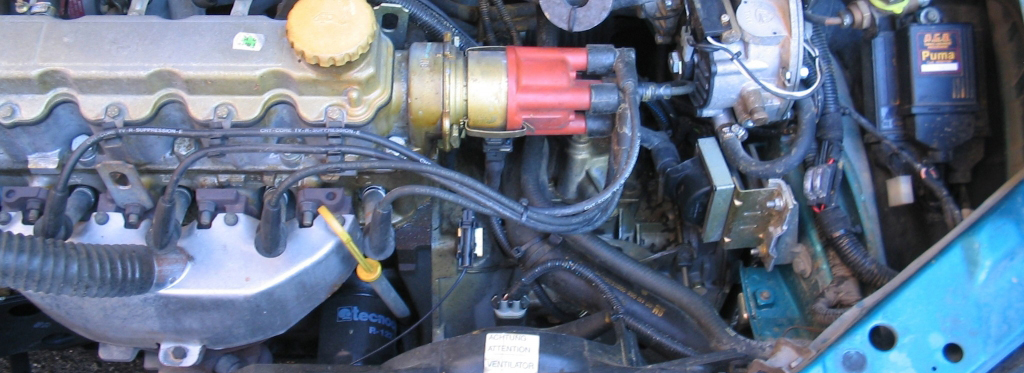
Automotive ignition systems can be divided into three types: conventional ignition system, electronic ignition system and distributorless ignition system.
In this article, we talk about three kinds of vehicle ignition systems. You can read about the improvement of engine ignition systems (with the progress of science and technology). Those give a comprehensive knowledge of the development of this essential system in the engine.
1. Conventional ignition system
3. Distributorless ignition system
1. Conventional ignition system
In the early generation of automotive ignition systems, ignition systems with contacts came onto the earliest stage. The mechanical contacts driven by cams mainly control the primary circuit. High voltage electricity finally produces in the secondary circuit.
When you turn on the ignition switch, the disconnector contacts are just in a closed state. Then the circuit of low voltage current will be turned on.
The low voltage current that goes through the line should start from the battery's positive terminal to the ammeter A. It comes to the ignition coil and terminal through the ignition switch. Next, it goes to the additional resistor and another terminal of the ignition coil. Then it goes through the disconnector contact K and the latch, and finally to the battery's negative terminal.

If the breaker cam collides the contact away when it rotates, the low voltage current will be cut off. At this time, both the secondary winding and the primary winding will be induced to generate electric potential. However, because the secondary winding has more turns, it will generate a high voltage of 15 to 25 kV.
This high voltage electricity can completely puncture the spark plug electrode gap to produce an electric spark. The process ignites the combustible air-fuel mixture.
If the primary winding turns are not relatively too many, the induction potential is low. It is generally in the range of 200 to 300 V. In order to avoid sparking in contacts and to protect contacts from ablation, a capacitor can be connected in parallel to absorb the self-induced potential.
The high voltage current passes through the wire from the ignition coil's secondary winding to the additional resistor. Then it goes through the ignition switch SW to the ammeter A. And finally, it passes through the battery to the latch and goes through the spark plug to the neutral electrode and the distributor side electrode.
The current passes through the distributor, and finally, it reaches the secondary winding.
The advantages of the conventional ignition system are its easy maintenance, cheap and simple structure. But it also has its own disadvantages: the contacts are very easy to produce electric sparks. The contacts are easily ablated to affect the contact, especially when the engine speed is relatively high.
The time of the contact closure is short. The insufficient high-voltage current will cause a high-speed misfire so that the engine is unstable and shaky while running.
The contacts in the ignition system can be prone to become defective with poor contact, metal fatigue and cam wear.

The technology of transistors evolved. The integrated circuits were created. So we improved the conventional ignition system and finally formed the electronic ignition system.
The conventional ignition system is as described above. The disconnector contacts are susceptible to ablation. To solve this issue, we improve it by using a switching transistor instead of contacts so that the trigger signal works.
This makes the transistor cutoff and conduction. It finally lets the breaking and connection of the primary circuit reach the goal. Finally, the high voltage electricity generates.
This triode can play a switching role. We also call it an ignition module or ignition controller. The ignition controller's trigger signal is mainly divided into Hall type, photoelectric type, magnetoelectric type and the other.
These signals are sent to the control terminal of the ignition controller to allow the electronic switch to be controlled. The electronic switch does not react with poor contact.

Two ends of the contact do not produce sparks, which improves the disadvantages of the conventional ignition system.
However, it is still impossible to precisely control the ignition advance angle because the ignition module is automatically adjusted. It regulates according to the engine speed, but the complexity of the ignition module also affects the accuracy of the adjustment. This is why it produces imprecise control.
3. Distributorless ignition system
With the rapid development of microcomputers, the engine controlled by the microcomputer has replaced the ignition module.
The microcomputer's powerful and fast calculation and control function can detect the engine speed, water temperature, burst signal, change of load, and the working condition of automatic transmission at any time according to the need to change the ignition advance angle.
This whole process achieves the purpose of precise control.

The distributorless ignition system mainly consists of various sensors, engine control unit (ECU) and ignition system.
Various sensors include the knock sensor, temperature sensor, engine speed sensor, crankshaft position sensor and vehicle speed sensor, etc. The ignition actuator mainly composes of spark plugs, distributor, ignition coil and ignition module, etc.
The crankshaft speed sensor, crankshaft position sensor, knock sensor, water temperature sensor and other types of sensors transform information to the ECU. Then the ECU finishes the comprehensive processing. It sends the ignition command to the ignitor.
The ignition coil and spark plug finish the ignition task. The actuator sends the feedback of the ignition implementation signal to the microcomputer ECU.
The whole control process is achieved by relying on the computer's powerful ability to analyze and process data. It constantly corrects the ignition advance angle according to the different operating conditions of the engine to obtain the best ignition moment.
The system improves the engine performance. It makes the engine work with the optimum power and economy and the least emission pollution.
There are three kinds of ignition systems in the automobile industry. By analyzing working principles and characteristics of these three systems, this article divides the automotive ignition systems into three types according to the structure: distributorless ignition system, electronic ignition system, and conventional ignition system.
These three systems also represent the development of the vehicle ignition system. The improvement of ignition systems is based on the achievement and application of the development of science and technology.
The progress of computer technology and the development of transistors improve the comprehensive upgrade of the car ignition system.

We have explored the development and progress of automotive ignition systems. Then we clarify the entirety of automotive ignition systems in the development process under continuous improvements based on scientific development.
We not only learn how to classify the automotive ignition system but also understand the working principle and entire process of the development.
Thinking about buying other car parts? You can’t beat the prices here at delcoribo.com. No matter what you need, we’re sure to have it in stock – take a look online.
 Lauritz Carolsfeld
Lauritz Carolsfeld  October 08, 2021
October 08, 2021